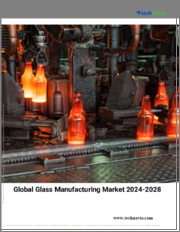
|
시장보고서
상품코드
1607188
세계의 유리 제조 시장 : 제품별, 용도별 예측(2025-2030년)Glass Manufacturing Market by Product (Container Glass, Fiber Glass, Flat Glass), Application (Construction, Electrical & Electronics, Packaging) - Global Forecast 2025-2030 |
||||||
유리 제조 시장의 2023년 시장 규모는 1,147억 3,000만 달러로 평가되었습니다. 2024년에는 1,208억 3,000만 달러에 달할 것으로 예측되며, CAGR 5.62%로 성장하여 2030년에는 1,683억 4,000만 달러에 달할 것으로 예측됩니다.
유리 제조 산업은 자동차용 유리, 건축용 유리, 포장용 유리, 기술용 유리 등 다양한 유리 제품의 제조와 관련된 광범위한 범위를 포함하고 있습니다. 투명성, 내약품성 등의 기능적인 이점으로 인해 필수적입니다. 이 시장의 주된 성장 촉진요인으로는 도시화의 진전, 에너지 절약 건물에 대한 수요 증가, 유리 제조 기술의 진보 등을 들 수 있습니다. 가전제품에서 가볍고 내구성있는 유리의 사용 확대는 큰 성장 기회를 제공합니다. 정부의 인센티브는 시장 전망을 더욱 높여주고 있습니다. 높은 생산 방법과 비용 효율적인 재료 개발에 중점을 둔 기술 혁신이 필요합니다. 연구가 비약적인 진보를 가져오는 스마트 유리나 특수 유리에 있어서도, 기술 혁신은 매우 중요합니다. 광 제어 기능을 갖춘 스마트 유리 등이 있습니다. 또한 디지털 유리 인쇄 및 코팅의 진보는 확대를위한 유망한 길을 보여줍니다. 기업은 기존의 한계를 극복하기 위한 연구개발 투자를 우선하고 헬스케어 환경에서 항균유리의 요구 증가와 같은 틈새 시장을 개척해야 합니다. 혁신을 수행하고 소비자의 요점 요구와 규제 요건에 적응할 필요가 있습니다. 새로운 동향과 고객 선호에 대응한 제품을 전략적으로 제공함으로써 기업은 과제를 극복하고 성장 기회를 활용할 수 있어 항상 진화 계속하는 유리 제조 중에서 확고한 발전을 이룰 수 있습니다.
| 주요 시장 통계 | |
|---|---|
| 기준년(2023) | 1,147억 3,000만 달러 |
| 추정년(2024) | 1,208억 3,000만 달러 |
| 예측년(2030) | 1,683억 4,000만 달러 |
| CAGR(%) | 5.62% |
시장 역학: 빠르게 진화하는 유리 제조 시장의 주요 시장 인사이트 공개
유리제조시장은 수요 및 공급의 역동적인 상호작용에 의해 변모를 이루고 있습니다. 비즈니스 기회를 얻을 수 있습니다. 이러한 동향을 종합적으로 파악함으로써 기업은 정치적, 지리적, 기술적, 사회적, 경제적 영역에 걸친 다양한 리스크를 완화할 수 있으며, 또한 소비자 행동과 그것이 제조 비용과 구매 동향에 미치는 영향을 보다 명확하게 이해할 수 있습니다.
- 시장 성장 촉진요인
- 주택 및 상업 건물의 현저한 성장
- 리사이클 가능한 제품으로의 시프트 증가
- 여러 최종 사용자 분야에서 유리 제품 수요 증가
- 시장 성장 억제요인
- 원재료 비용 변동에 대한 우려
- 시장 기회
- 유리 제조 산업의 기술 혁신
- 유리의 새로운 용도의 출현
- 시장의 과제
- 유리 대체 제품의 존재
Porter's Five Force : 유리 제조 시장을 탐색하는 전략 도구
Porter's Five Force는 시장 상황경쟁 구도를 파악하는 중요한 도구입니다. 명확한 기술을 제공합니다. 기업이 시장 내 세력도를 평가하고 신규 사업의 수익성을 판단할 수 있도록 도와줍니다. 당신은 더 강인한 시장에서 포지셔닝을 보장할 수 있습니다.
PESTLE 분석 : 유리 제조 시장에서 외부로부터의 영향 파악
외부 거시 환경 요인은 유리 제조 시장의 성과 역학을 형성하는 데 매우 중요한 역할을합니다. PESTLE 요인을 조사함으로써 기업은 잠재적인 위험과 기회를 더 잘 이해할 수 있습니다. 예측할 수 있는 적극적인 의사 결정을 할 준비가 되었습니다.
시장 점유율 분석 : 유리 제조 시장 경쟁 구도 파악
유리 제조 시장의 상세한 시장 점유율 분석을 통해 공급업체의 성과를 종합적으로 평가할 수 있습니다. 분명 이 분석을 통해 시장 집중, 단편화, 통합 동향을 밝혀내고 벤더는 경쟁이 치열해지면서 자사의 지위를 높이는 전략적 의사결정을 하기 위해 필요한 지견 을 얻을 수 있습니다.
FPNV 포지셔닝 매트릭스 : 유리 제조 시장에서 공급업체의 성능 평가
FPNV 포지셔닝 매트릭스는 유리 제조 시장에서 벤더를 평가하는 중요한 도구입니다. 기본 결정을 내릴 수 있습니다. 네 가지 사분면을 통해 벤더를 명확하고 정확하게 분류하고 전략 목표에 가장 적합한 파트너 및 솔루션을 파악할 수 있습니다.
전략 분석 및 권장 : 유리 제조 시장에서 성공을 위한 길을 그리기
글래스 제조 시장의 전략 분석은 세계 시장에서의 프레즌스 강화를 목표로 하는 기업에 필수적입니다. 이 접근법을 통해 경쟁 구도에서 과제를 극복하고 새로운 비즈니스 기회를 활용하여 장기적인 성공을 거둘 수 있는 체제를 구축할 수 있습니다.
이 보고서는 주요 관심 분야를 포괄하는 시장의 종합적인 분석을 제공합니다.
1. 시장 침투: 현재 시장 환경의 상세한 검토, 주요 기업의 광범위한 데이터, 시장 도달범위 및 전반적인 영향력 평가.
2. 시장 개척도: 신흥 시장의 성장 기회를 파악하고, 기존 분야의 확장 가능성을 평가하고, 미래 성장을 위한 전략적 로드맵을 제공합니다.
3. 시장 다양화: 최근 제품 출시, 미개척 지역, 업계의 주요 진보, 시장을 형성하는 전략적 투자를 분석합니다.
4. 경쟁 평가 및 정보 : 경쟁 구도를 철저히 분석하여 시장 점유율, 사업 전략, 제품 포트폴리오, 인증, 규제 당국 승인, 특허 동향, 주요 기업의 기술 진보 등을 검증합니다.
5. 제품 개발 및 혁신 : 미래 시장 성장을 가속할 것으로 예상되는 최첨단 기술, R&D 활동, 제품 혁신을 강조합니다.
또한 이해관계자가 충분한 정보를 얻고 의사결정을 할 수 있도록 중요한 질문에 대답하고 있습니다.
1. 현재 시장 규모와 향후 성장 예측은?
2. 최고의 투자 기회를 제공하는 제품, 부문 및 지역은 어디입니까?
3. 시장을 형성하는 주요 기술 동향과 규제의 영향은?
4. 주요 벤더의 시장 점유율과 경쟁 포지션은?
5. 벤더 시장 진입·철수 전략의 원동력이 되는 수익원과 전략적 기회는 무엇인가?
목차
제1장 서문
제2장 조사 방법
제3장 주요 요약
제4장 시장 개요
제5장 시장 인사이트
- 시장 역학
- 성장 촉진요인
- 주택과 상업 건물의 대폭 증가
- 재활용 가능한 제품으로의 전환 증가
- 여러 최종 사용자 부문에서 유리 제품에 대한 수요 급증
- 억제요인
- 원재료비 변동에 대한 우려
- 기회
- 유리 제조 업계의 혁신
- 유리의 새로운 용도
- 과제
- 유리 대체 제품의 존재
- 성장 촉진요인
- 시장 세분화 분석
- Porter's Five Forces 분석
- PESTEL 분석
- 정치
- 경제
- 사회
- 기술
- 법률
- 환경
제6장 유리 제조 시장 : 제품별
- 용기 유리
- 섬유 유리
- 판유리
제7장 유리 제조 시장 : 용도별
- 공사
- 전기 및 전자
- 패키지
- 통신
- 교통기관
제8장 아메리카의 유리 제조 시장
- 아르헨티나
- 브라질
- 캐나다
- 멕시코
- 미국
제9장 아시아태평양의 유리 제조 시장
- 호주
- 중국
- 인도
- 인도네시아
- 일본
- 말레이시아
- 필리핀
- 싱가포르
- 한국
- 대만
- 태국
- 베트남
제10장 유럽·중동 및 아프리카의 유리 제조 시장
- 덴마크
- 이집트
- 핀란드
- 프랑스
- 독일
- 이스라엘
- 이탈리아
- 네덜란드
- 나이지리아
- 노르웨이
- 폴란드
- 카타르
- 러시아
- 사우디아라비아
- 남아프리카
- 스페인
- 스웨덴
- 스위스
- 터키
- 아랍에미리트(UAE)
- 영국
제11장 경쟁 구도
- 시장 점유율 분석 2023
- FPNV 포지셔닝 매트릭스, 2023
- 경쟁 시나리오 분석
- 전략 분석과 제안
기업 목록
- AGC Inc.
- AIS Glass
- Compagnie de Saint-Gobain SA
- Corning Incorporated
- CSG Holding Co., Ltd.
- Guardian Glass LLC
- Kyocera Corporation
- Morgan Advanced Materials
- Nippon Electric Glass Co., Ltd.
- Nippon Sheet Glass Co., Ltd.
- Owens Illinois Inc.
- Schott AG
- Sisecam Group
- Vetropack
- Vitro
The Glass Manufacturing Market was valued at USD 114.73 billion in 2023, expected to reach USD 120.83 billion in 2024, and is projected to grow at a CAGR of 5.62%, to USD 168.34 billion by 2030.
The glass manufacturing industry encompasses a broad scope involving the creation of various glass products, including automotive, construction, packaging, and technical glass. It is essential not only for aesthetic applications but also for its functional benefits like insulation, transparency, and chemical resistance. The end-use segments primarily include construction, automotive, electronics, and consumer goods, each contributing significantly to market growth. Key growth drivers in this market include rising urbanization, increasing demand for energy-efficient buildings, and advancements in glass manufacturing technologies. The surge in smart glass and the expanding use of lightweight, durable glass in automotive and consumer electronics offer substantial growth opportunities. Improved recycling processes and government incentives towards sustainable building practices further enhance market prospects. However, the market faces challenges such as high energy consumption in manufacturing, volatility in raw material prices, and stringent regulatory constraints related to environmental concerns. These limitations necessitate innovation focused on energy-efficient production methods and the development of cost-effective materials. Innovations are also critical in smart and specialty glass, where research into enhanced durability, energy efficiency, and functionality can drive breakthroughs. Key areas for innovation include solar-control glass, laminated glass for enhanced safety, and smart glass with dynamic light control capabilities. Furthermore, advancements in digital glass printing and coatings represent promising avenues for expansion. Businesses should prioritize investment in R&D to overcome existing limitations and explore niche markets like the growing need for antimicrobial glass in healthcare settings. The market is dynamic and competitive, with a need for companies to continuously innovate and adapt to consumer demands and regulatory requirements. By strategically aligning their offerings with emerging trends and customer preferences, businesses can navigate challenges and capitalize on growth opportunities, ensuring robust development in the ever-evolving landscape of glass manufacturing.
| KEY MARKET STATISTICS | |
|---|---|
| Base Year [2023] | USD 114.73 billion |
| Estimated Year [2024] | USD 120.83 billion |
| Forecast Year [2030] | USD 168.34 billion |
| CAGR (%) | 5.62% |
Market Dynamics: Unveiling Key Market Insights in the Rapidly Evolving Glass Manufacturing Market
The Glass Manufacturing Market is undergoing transformative changes driven by a dynamic interplay of supply and demand factors. Understanding these evolving market dynamics prepares business organizations to make informed investment decisions, refine strategic decisions, and seize new opportunities. By gaining a comprehensive view of these trends, business organizations can mitigate various risks across political, geographic, technical, social, and economic domains while also gaining a clearer understanding of consumer behavior and its impact on manufacturing costs and purchasing trends.
- Market Drivers
- Significant growth of residential and commercial building
- Rising shift towards the recyclable products
- Proliferating demand of glass products in multiple end-user sectors
- Market Restraints
- Concern regarding fluctuating cost of raw materials
- Market Opportunities
- Innovations in glass manufacturing industry
- Emerging novel applications of glass
- Market Challenges
- Presence of glass alternative products
Porter's Five Forces: A Strategic Tool for Navigating the Glass Manufacturing Market
Porter's five forces framework is a critical tool for understanding the competitive landscape of the Glass Manufacturing Market. It offers business organizations with a clear methodology for evaluating their competitive positioning and exploring strategic opportunities. This framework helps businesses assess the power dynamics within the market and determine the profitability of new ventures. With these insights, business organizations can leverage their strengths, address weaknesses, and avoid potential challenges, ensuring a more resilient market positioning.
PESTLE Analysis: Navigating External Influences in the Glass Manufacturing Market
External macro-environmental factors play a pivotal role in shaping the performance dynamics of the Glass Manufacturing Market. Political, Economic, Social, Technological, Legal, and Environmental factors analysis provides the necessary information to navigate these influences. By examining PESTLE factors, businesses can better understand potential risks and opportunities. This analysis enables business organizations to anticipate changes in regulations, consumer preferences, and economic trends, ensuring they are prepared to make proactive, forward-thinking decisions.
Market Share Analysis: Understanding the Competitive Landscape in the Glass Manufacturing Market
A detailed market share analysis in the Glass Manufacturing Market provides a comprehensive assessment of vendors' performance. Companies can identify their competitive positioning by comparing key metrics, including revenue, customer base, and growth rates. This analysis highlights market concentration, fragmentation, and trends in consolidation, offering vendors the insights required to make strategic decisions that enhance their position in an increasingly competitive landscape.
FPNV Positioning Matrix: Evaluating Vendors' Performance in the Glass Manufacturing Market
The Forefront, Pathfinder, Niche, Vital (FPNV) Positioning Matrix is a critical tool for evaluating vendors within the Glass Manufacturing Market. This matrix enables business organizations to make well-informed decisions that align with their goals by assessing vendors based on their business strategy and product satisfaction. The four quadrants provide a clear and precise segmentation of vendors, helping users identify the right partners and solutions that best fit their strategic objectives.
Strategy Analysis & Recommendation: Charting a Path to Success in the Glass Manufacturing Market
A strategic analysis of the Glass Manufacturing Market is essential for businesses looking to strengthen their global market presence. By reviewing key resources, capabilities, and performance indicators, business organizations can identify growth opportunities and work toward improvement. This approach helps businesses navigate challenges in the competitive landscape and ensures they are well-positioned to capitalize on newer opportunities and drive long-term success.
Key Company Profiles
The report delves into recent significant developments in the Glass Manufacturing Market, highlighting leading vendors and their innovative profiles. These include AGC Inc., AIS Glass, Compagnie de Saint-Gobain S.A., Corning Incorporated, CSG Holding Co., Ltd., Guardian Glass LLC, Kyocera Corporation, Morgan Advanced Materials, Nippon Electric Glass Co., Ltd., Nippon Sheet Glass Co., Ltd., Owens Illinois Inc., Schott AG, Sisecam Group, Vetropack, and Vitro.
Market Segmentation & Coverage
This research report categorizes the Glass Manufacturing Market to forecast the revenues and analyze trends in each of the following sub-markets:
- Based on Product, market is studied across Container Glass, Fiber Glass, and Flat Glass.
- Based on Application, market is studied across Construction, Electrical & Electronics, Packaging, Telecommunication, and Transportation.
- Based on Region, market is studied across Americas, Asia-Pacific, and Europe, Middle East & Africa. The Americas is further studied across Argentina, Brazil, Canada, Mexico, and United States. The United States is further studied across California, Florida, Illinois, New York, Ohio, Pennsylvania, and Texas. The Asia-Pacific is further studied across Australia, China, India, Indonesia, Japan, Malaysia, Philippines, Singapore, South Korea, Taiwan, Thailand, and Vietnam. The Europe, Middle East & Africa is further studied across Denmark, Egypt, Finland, France, Germany, Israel, Italy, Netherlands, Nigeria, Norway, Poland, Qatar, Russia, Saudi Arabia, South Africa, Spain, Sweden, Switzerland, Turkey, United Arab Emirates, and United Kingdom.
The report offers a comprehensive analysis of the market, covering key focus areas:
1. Market Penetration: A detailed review of the current market environment, including extensive data from top industry players, evaluating their market reach and overall influence.
2. Market Development: Identifies growth opportunities in emerging markets and assesses expansion potential in established sectors, providing a strategic roadmap for future growth.
3. Market Diversification: Analyzes recent product launches, untapped geographic regions, major industry advancements, and strategic investments reshaping the market.
4. Competitive Assessment & Intelligence: Provides a thorough analysis of the competitive landscape, examining market share, business strategies, product portfolios, certifications, regulatory approvals, patent trends, and technological advancements of key players.
5. Product Development & Innovation: Highlights cutting-edge technologies, R&D activities, and product innovations expected to drive future market growth.
The report also answers critical questions to aid stakeholders in making informed decisions:
1. What is the current market size, and what is the forecasted growth?
2. Which products, segments, and regions offer the best investment opportunities?
3. What are the key technology trends and regulatory influences shaping the market?
4. How do leading vendors rank in terms of market share and competitive positioning?
5. What revenue sources and strategic opportunities drive vendors' market entry or exit strategies?
Table of Contents
1. Preface
- 1.1. Objectives of the Study
- 1.2. Market Segmentation & Coverage
- 1.3. Years Considered for the Study
- 1.4. Currency & Pricing
- 1.5. Language
- 1.6. Stakeholders
2. Research Methodology
- 2.1. Define: Research Objective
- 2.2. Determine: Research Design
- 2.3. Prepare: Research Instrument
- 2.4. Collect: Data Source
- 2.5. Analyze: Data Interpretation
- 2.6. Formulate: Data Verification
- 2.7. Publish: Research Report
- 2.8. Repeat: Report Update
3. Executive Summary
4. Market Overview
5. Market Insights
- 5.1. Market Dynamics
- 5.1.1. Drivers
- 5.1.1.1. Significant growth of residential and commercial building
- 5.1.1.2. Rising shift towards the recyclable products
- 5.1.1.3. Proliferating demand of glass products in multiple end-user sectors
- 5.1.2. Restraints
- 5.1.2.1. Concern regarding fluctuating cost of raw materials
- 5.1.3. Opportunities
- 5.1.3.1. Innovations in glass manufacturing industry
- 5.1.3.2. Emerging novel applications of glass
- 5.1.4. Challenges
- 5.1.4.1. Presence of glass alternative products
- 5.1.1. Drivers
- 5.2. Market Segmentation Analysis
- 5.3. Porter's Five Forces Analysis
- 5.3.1. Threat of New Entrants
- 5.3.2. Threat of Substitutes
- 5.3.3. Bargaining Power of Customers
- 5.3.4. Bargaining Power of Suppliers
- 5.3.5. Industry Rivalry
- 5.4. PESTLE Analysis
- 5.4.1. Political
- 5.4.2. Economic
- 5.4.3. Social
- 5.4.4. Technological
- 5.4.5. Legal
- 5.4.6. Environmental
6. Glass Manufacturing Market, by Product
- 6.1. Introduction
- 6.2. Container Glass
- 6.3. Fiber Glass
- 6.4. Flat Glass
7. Glass Manufacturing Market, by Application
- 7.1. Introduction
- 7.2. Construction
- 7.3. Electrical & Electronics
- 7.4. Packaging
- 7.5. Telecommunication
- 7.6. Transportation
8. Americas Glass Manufacturing Market
- 8.1. Introduction
- 8.2. Argentina
- 8.3. Brazil
- 8.4. Canada
- 8.5. Mexico
- 8.6. United States
9. Asia-Pacific Glass Manufacturing Market
- 9.1. Introduction
- 9.2. Australia
- 9.3. China
- 9.4. India
- 9.5. Indonesia
- 9.6. Japan
- 9.7. Malaysia
- 9.8. Philippines
- 9.9. Singapore
- 9.10. South Korea
- 9.11. Taiwan
- 9.12. Thailand
- 9.13. Vietnam
10. Europe, Middle East & Africa Glass Manufacturing Market
- 10.1. Introduction
- 10.2. Denmark
- 10.3. Egypt
- 10.4. Finland
- 10.5. France
- 10.6. Germany
- 10.7. Israel
- 10.8. Italy
- 10.9. Netherlands
- 10.10. Nigeria
- 10.11. Norway
- 10.12. Poland
- 10.13. Qatar
- 10.14. Russia
- 10.15. Saudi Arabia
- 10.16. South Africa
- 10.17. Spain
- 10.18. Sweden
- 10.19. Switzerland
- 10.20. Turkey
- 10.21. United Arab Emirates
- 10.22. United Kingdom
11. Competitive Landscape
- 11.1. Market Share Analysis, 2023
- 11.2. FPNV Positioning Matrix, 2023
- 11.3. Competitive Scenario Analysis
- 11.4. Strategy Analysis & Recommendation
Companies Mentioned
- 1. AGC Inc.
- 2. AIS Glass
- 3. Compagnie de Saint-Gobain S.A.
- 4. Corning Incorporated
- 5. CSG Holding Co., Ltd.
- 6. Guardian Glass LLC
- 7. Kyocera Corporation
- 8. Morgan Advanced Materials
- 9. Nippon Electric Glass Co., Ltd.
- 10. Nippon Sheet Glass Co., Ltd.
- 11. Owens Illinois Inc.
- 12. Schott AG
- 13. Sisecam Group
- 14. Vetropack
- 15. Vitro

















